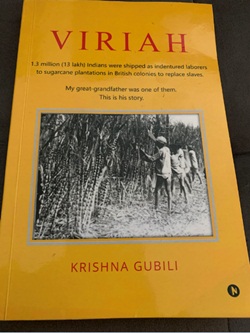Krishna Gubili was born in 1970 in Hyderabad, India and currently lives lives in Easton, Pennsylvania, in the US with his wife and daughter. An alumnus of JNTU College of Engineering, Hyderabad and Indian Institute of Management, Lucknow, Gubili is passionate about history, travel and cricket.
In this interview with Swetha Amit, he talks about his debut book Viriah, the entire research process and what kept him doing through this arduous search for his ancestors.
What was the inspiration behind this book? How did the idea initially originate?
It was around Spring in 2015. I had just returned from my trip to South Africa. At that time, I found that very few people had heard of the indenture system that was prevalent many years ago. It occurred to me that maybe I should write a book on this. The journey started then, and it took me four years to complete this project.
Writing a book on your ancestors would have required tremendous amount of research. How did you go about the entire process?
I did a decade plus search about the indenture system and that really helped. During the search for my great grandfather, I dug up a lot of information and accumulated an entire pile of material. The first year was spent in assimilating this material. It was really useful as I didn’t have to start from scratch.
During your search, you say you hit a dead end many times. How did you keep going despite this?
During such tough times you have got to find that extra spark to keep going despite hitting a dead end. For me that extra spark was the promise made to my grandmother, which kept me persevering.
Sometimes, when I travelled from one place to another and there was a flight delay, I would pause and reflect on what my great grandfather would have undergone on a ship. It made me feel that I was complaining despite being in a comfortable setting like an airport while my ancestor would be battling turbulent conditions. Moments like these propelled my resolve to find him every time I hit a dead end.
Coming to the appalling indenture system, you mentioned it was different from slavery. What was the difference between the two?
There is a very thin line between slavery and the indenture system. Indenture is like quasi-slavery. Slavery was considered illegal after a point. In this fancy jargon called indenture, there was an agreement on paper. However, in reality, these coolies were treated like slaves. In slavery the wages, transportation, and food were all under someone else’s control. The plantation owners in this case controlled every aspect of a coolie’s lives. In slavery, the workers were almost like the owners’ property whereas in the indenture system there was a specific time period till the workers could work for you.
There is a line in the book: “no matter how educated you are, the color of your skin pretty much decided what you could or could not do.” Have changed today in the world?
At a broader level, I think we still need to learn a lot. At a social level, I feel that the colour still seems to matter. Its sadly true but that’s the reality everywhere.
Viriahalso takes you to the times where social evils such as the caste system and dowry were predominant in India. How much do you think has changed?
Sadly, there is still a lot of these social evils in India. Especially in the remote parts of the country where the caste system is still predominant. Some of the children from the lower caste aren’t allowed to sit in the same classroom as the children from the upper caste. No matter how much we try to white wash and progress, we still have a lot more work to do.
During the indenture period, the caste system was seen crumbling and everyone had to share the same space. There is a sense of irony here where on one hand, there was cruelty meted out and on the other, people were forced to mingle with one another. What is your take on this?
It is certainly an irony. In India, the Brahmin community wouldn’t have gone anywhere close to someone from the lower caste. In the ship, it was poignant to see how these people irrespective of caste and color, stuck together as they were bound by a common problem. What thousand years of reform could not do, the indenture system managed to do so in a jiffy.
Back then when people travelled from places like Kanpur to Calcutta, it was a harrowing journey on bullock carts and trains. Those were instances when the social structure crumbled as people were forced to coexist with one another during their long tenure.
The theme of freedom predominates your book. What does freedom mean to you today?
Freedom has different connotations for different classes. For me freedom is more at a simple level and this is more from the perspective of the coolies. Freedom to me is dignity of labour. It’s important for people to be able to go to work and get paid without being harassed. They should also have the freedom to move between employers, live comfortably with clean air and water. Women should be eligible for education and work with equal pay. Education again is a huge milestone for society.
Are you planning any more books?
This book itself was a long journey. I never thought I would find my roots or that I could write a book. Now that both these things are ticked off my bucket list, I want to help many in South Africa locate their Indian roots.
I met so many Indians in South Africa who are still looking for their families back in India. The ship records are in a pitiable state and it’s not easy for people to trace their families. I am attempting a project which will provide them a data base to help find their families. I am hoping to find someone who can help in digitizing these records. It will create a whole volume of history which otherwise would be washed away with time. It’s my dream and it will be great if it happens.
































